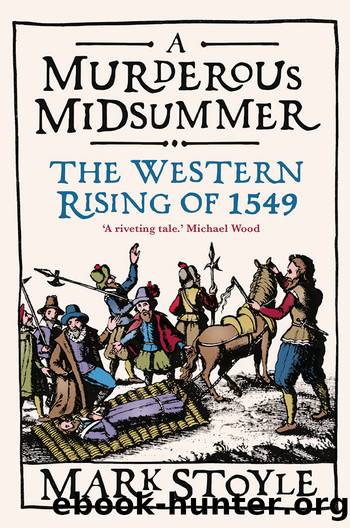A Murderous Midsummer by Mark Stoyle

Author:Mark Stoyle
Language: eng
Format: epub
ISBN: 9780300269079
Publisher: Yale University Press
III
According to Hooker, Russellâs decision ânowe to loose no more time, but to give the adventure upon the enemieâ was prompted, first, by the arrival of the long-awaited reinforcements under Lord Grey, and second, by the fact that the lord privy seal had recently been âadvertisedâ from Exeter that the city was in desperate straits and could not hope to hold out for much longer.43 Both of these factors were surely critical in prompting Russell finally to seek a conclusion with the rebels, but it is possible that the kingâs lieutenant in the West was swayed by a third consideration, too. Ellis Gruffydd, a Welsh soldier serving in the English garrison of Calais, later recorded that âthe Lord Privy Seal saw his opportunity to attack the besiegers before the Cornishmen arrivedâ. This statement suggests that, while some of the Cornish rebel forces had arrived before Exeter in time to take part in the action at Fenny Bridges on 27 July, many of their fellow countrymen were still in the process of marching up from the west: meaning that Russell â having received his own reinforcements â now had a precious window of time in which to act before the rebels could concentrate all of their own forces.44
The events of the next three days may be reconstructed from Hookerâs later accounts and from a letter sent by John Fry â one of the loyalist gentlemen who was serving in the kingâs army â to John Thynne just two weeks afterwards. On Saturday, 3 August, Russellâs forces set out from Honiton and, after having diverted from the line of the main road â perhaps because it had been barricaded by the rebels â they marched âover the downsâ to Woodbury, some 9 miles to the south-east of Exeter. Here, the kingâs army halted beside a windmill that formed a prominent feature in the local landscape. Four miles north-west of Woodbury lies Clyst St Mary, the village that had been a key rebel centre since the risings first began to escalate, and which now stood directly in the line of march between Russellâs forces and Exeter. According to Hooker, when âthe rebels of saint Marie Clistâ heard of the royal armyâs advance, they at once
with all their force and power came forth, and marched onwards, untill they came to the foresaid mill, where they offer[ed] the fight, and notwithstanding they were of verie stout stomachs, & also verie valiantlie did stand to their tackles [i.e., kept up the struggle], yet in the end they were overthrown, and the most parte of them slaine.45
Fry later estimated there were âslayne of the rebellesâ in this engagement âles than one hundredth, as I thykneâ, but âof our men none slayne .â.â. yt I hard ofâ â though he conceded that âafter ye end of ye fight were iii or iiii of our men slayne yt folyshely went abrode to spoyleâ: that is to say, to take goods by force from the local people, a practice that would henceforth be indulged in at every opportunity by the Crownâs forces in the South-West.
Download
This site does not store any files on its server. We only index and link to content provided by other sites. Please contact the content providers to delete copyright contents if any and email us, we'll remove relevant links or contents immediately.
| General | Channel Islands |
| England | Northern Ireland |
| Scotland | Wales |
Room 212 by Kate Stewart(5040)
The Crown by Robert Lacey(4723)
Endurance: Shackleton's Incredible Voyage by Alfred Lansing(4677)
The Iron Duke by The Iron Duke(4293)
The Rape of Nanking by Iris Chang(4139)
Joan of Arc by Mary Gordon(4016)
Killing England by Bill O'Reilly(3953)
Say Nothing by Patrick Radden Keefe(3903)
I'll Give You the Sun by Jandy Nelson(3359)
Shadow of Night by Deborah Harkness(3304)
Hitler's Monsters by Eric Kurlander(3269)
Mary, Queen of Scots, and the Murder of Lord Darnley by Alison Weir(3150)
Blood and Sand by Alex Von Tunzelmann(3140)
Darkest Hour by Anthony McCarten(3072)
Eleanor & Park by Rainbow Rowell(3063)
Margaret Thatcher: The Autobiography by Thatcher Margaret(3029)
Red Famine: Stalin's War on Ukraine by Anne Applebaum(2873)
Book of Life by Deborah Harkness(2868)
The One Memory of Flora Banks by Emily Barr(2803)
